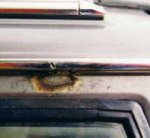It may branch into various paths or it may just punch a hole right through it and vaporize parts of it.
The problem with lightning is that no two strokes are alike. Also, they can be multi-stroke and act like a half million volt electrical jack hammer.
I think I already mentioned that I have seen a pane of window glass with a hole burned through it by lightning. It didn't break the glass, it just melted about a 2 inch hole through it.
Sometimes cars get hit by lightning, even though it's an old wive's tale that they don't. When they do get hit, sometimes not much even happens to the car, other times it blows the windows out of them.
I live in an area where there is plenty of lightning. I get to see what it does up close and personal.
I applaud your efforts to take the time to consider a means to make a safer workplace so long as it's not a means to keep workers on the job in a possibly deadly environment.
If you are really interested in lightning hazard mitigation check out this site:
http://www.protectiongroup.com/Home
This link is the best info a construction worker can heed in a thunder storm:
http://docs.google.com/viewer?a=v&q...pFwUvy&sig=AHIEtbQEqt3yLlZ6kDN3ODYEdOODPmP_uQ
Note that is says DO NOT stand near tall metal structures such as communications towers.
It says DO go inside and ENCLOSED building.
Again, communications towers employ the best bonding and lightning protection known to man. That protection keeps the gear safe, but NOT personnel outside near the tower.
A building being built is not usually and enclosed building. That means during a storm, get OUT of that building.
You seem to be making many assumptions about lightning that just aren't true. Lightning can't be harnessed nor controlled like human generated electricity. There is no amount of insulation that can stop it. Since the actual voltage can't be measured, we have to guess. Conservative guesses are that the voltage can be as low as 500,000 and as high as 120,000,000 volts. The peak power can be trillions of watts. The temperature rises from ambient to over 50,000 degrees in 30 millionths of a second.
Due to it's ability to ionize the surrounding air and make it conductive it's impossible to create a means to guide it to a grounding electrode with pin point accuracy every time. Due to the fact that it pulses and acts like AC it has a 'frequency' which is not stable, in fact changes rapidly which also changes the impedance of any conductor, semi-conductor or insulator.
My contention is that if we can design a lightning-safe tower, we should be able to design shock proof everyday electrical equipment and conductors. FAR more people die from coming into contact with man made electricity than from lightning. If we can't keep people safe from 120 volts, it's really silly to think we can keep them safe from 100 million volts.
The standard safety procedure is the best, IF FOLLOWED, and that is to stop working and get to a safe area. The real problem is not that equipment is ill-designed, it's that the people will not follow the safety procedures.


